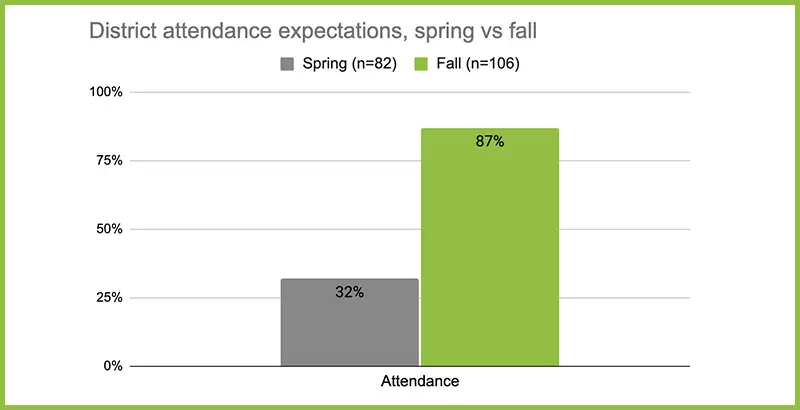As districts close out their first academic quarter, educators are reporting increased absenteeism rates for both remote learners (double the rates they saw before the pandemic) and in-person learners. About a third of educators say unexcused absences will impact student grades and, potentially, prevent some kids from passing to the next grade level.
Our analysis of reopening plans in 106 large, high-profile districts finds that they have taken student engagement and attendance far more seriously this fall than they did after schools first closed last spring. But many school systems have struggled to create consistent rules, especially for remote learners. The districts we’re tracking show that much can be done to improve how attendance is recorded and what actions can be taken to maintain high expectations without penalizing students for challenging circumstances.
While 32 percent (26 of 82) of districts in our database waived attendance expectations last spring, almost all (87 percent, or 92 of 106) directed schools to collect daily numbers this fall.
br2jbnln-jtjn6u9zt3bp4-8zzdp9zpcuknzt0zfnrt38eidxdz2fn1r7rk5r5me5e5_e9vyiyp6nwau_zm5lv6qgxzbnugwktiwiatkonbmw6rpg1unfi_llvcalrkpxren8rhe.jpg

However, what “attendance” means, especially for remote learners, is not so clear. As is the case with so many other aspects of schooling this year, students’ experience with attendance varies greatly by state to state and district to district.
Districts run the gamut on remote attendance approaches
Students in some districts face attendance policies designed to keep them in school. Others experience adjusted expectations that redefine attendance from presence in class to task completion.
Students in Chicago Public Schools, for example, are considered present if they receive at least five hours of instruction a day. Long Beach Unified School District in California counts students present so long as they complete the tasks assigned for that day. Similar policies abound across California, where the state has directed school districts to calculate the “time value” of work assigned to students. St. Paul Public Schools has adopted an entirely different approach, asking children’s caregivers to report their attendance.
Of the 100 districts reviewed, 16 provide detail on how they measure attendance using “engagement” metrics for remote learners, which generally include a combination of logging into online platforms, completing assignments or communicating with their teacher.
South Dakota’s Sioux Falls School District, for example, lists an array of measures for marking attendance, including student activity and submissions in course software and teacher-tracked work time.
At least three other districts link attendance to attaining course credit. Texas school systems say students are still subject to the “90 percent rule,” which states that students who miss more than 10 percent of class sessions will be denied credit even if they earn a passing grade. Students who miss more than 25 percent of a class become ineligible for credit restoration. But some state systems, like the Fort Worth Independent School District, give students multiple options for meeting these percentage requirements — including making progress in Google classroom, communicating with teachers and turning in assignments.
Two districts have decoupled attendance from grading policies. The New York City Department of Education, which temporarily shut down all school buildings Nov. 19, released guidelines stating that a lack of attendance will not hurt students’ grades. In Utah, Alpine Public Schools has taken similar measures, advising staff to remain flexible and consider the needs of each student.
A few districts created wellness policies that aim to prevent absenteeism by actively promoting student engagement. New York’s Buffalo Public Schools explicitly committed to shifting its attendance policy away from punitive measures and toward a strategy to reconnect students and families to school. Similarly, Indianapolis Public Schools is working to create a culture where all district students, families and staff understand the link between sustained attendance and overall well-being.
Districts are balancing high expectations with flexibility
Districts’ stances on attendance likely reflect different philosophies about what students need during the crisis. Do they need strong incentives and high expectations to encourage attendance and engagement, or more flexibility as they cope with disruptions both to the learning process and their everyday lives? School and district leaders are trying to navigate these tensions in the face of state laws and regulations designed to fund schools based on the amount of time students spend in physical classrooms — rules that may have been outdated before the pandemic and are now untenable under remote or hybrid learning plans.
Districts must balance their responsibility to get students to school (albeit remotely) with flexibility for unique circumstances. Attendance Works, a national initiative working to improve school attendance through policy and practice, recommends that districts offer three tiers of intervention: basic strategies to encourage good attendance, early assistance for students at risk of chronic absenteeism and intensive support for children facing the greatest challenges to attending school. Some of these policies include eliminating punitive approaches to absenteeism that can lead to legal consequences, calculating future school-year funding based on pre-pandemic attendance data and collaborating with community partners to eliminate technology gaps.
At minimum, students experiencing unusual circumstances should not be penalized for low daily attendance, but instead given options to demonstrate content mastery. Districts must take absenteeism seriously but maintain flexibility. Wellness-centered approaches can help balance holding students to high expectations and forgoing punishments that only set students back. But ultimately, if children are not showing up for class or logging in to virtual lessons, schools must ask why. They must understand and address the root causes of low attendance or poor engagement. And they should advocate for state policies that fund schools based on students’ needs and hold schools accountable for student learning, rather than the amount of time they spend in class.
This post originally appeared in The 74.






